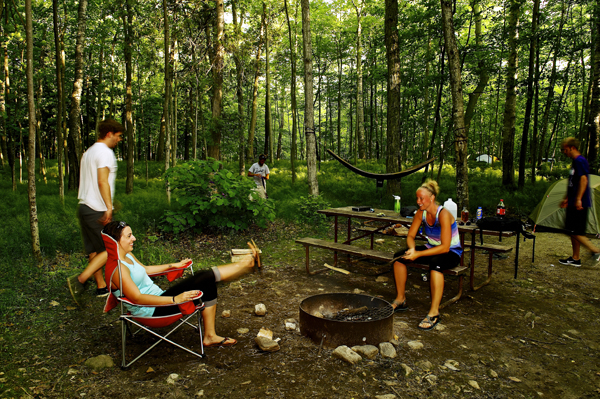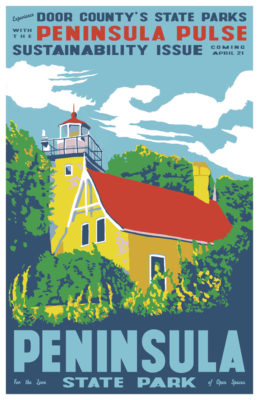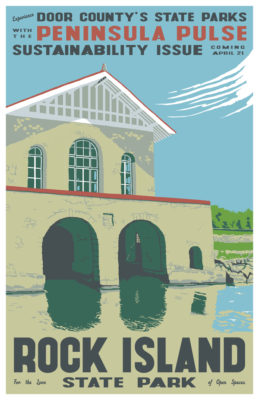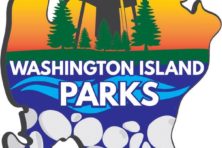Can Self-sustaining Funding Model Work for Wisconsin State Parks?
- Share
- Tweet
- Pin
- Share

In 2015, Governor Scott Walker eliminated state support for the state parks operating budget, mandating that they become self-sustaining. The move eliminated $4.7 million (28 percent) of the system’s $16.7 million budget for items such as staff, programming, maintenance and education.
The Wisconsin Department of Natural Resources (DNR) is considering a host of proposals to make up for the cuts, including demand-pricing, more public-private partnerships, sponsorships and fee increases.
How Parks Funding Works Today
Even before state funds were cut from the operating budget in 2015, the system was largely self-supporting. Park admission stickers, camping fees and trail passes generated most of the revenue in the state parks segregated fund. The system garners additional revenue from special events, commercial use permits, concessions, agriculture land rentals, snowmobile and ATV trail money, and interpretive program fees, according to Ben Bergey, director of the Wisconsin Bureau of Parks and Recreation.
Segregated funds are used only for park expenses, and are dispensed to all the parks regardless of where the money came from. This allows parks such as Interstate and Wildcat Mountain to stay open despite losing more than $200,000 a year each, according to 2012 data.
In 2015 the parks increased fees for the first time since 2008 to help make up for the cuts, raising sticker fees $3 and camping fees $3 – $11 depending on the park and time of year. Heading into 2017, however, the parks still faced a $1.4 million structural deficit.
Unless the state has a big change of heart before approval of the 2017-19 state budget, state parks must either increase revenues or decrease expenses.
Wisconsin’s Proposed Solutions
In December, a DNR report authored by Bergey outlined the possible revenue streams the parks could pursue, including:
- Selling sponsorship and naming rights for trails, shelters and other amenities
- Charging a $2 – $10 premium for admission and camping at high-demand parks and trails
- Increasing admission fees by $2 – $4 at all parks
- Expanding the number of campsites with electric service
- Creating individual admission passes rather than vehicle stickers
Bergey’s list did not include selling naming rights to the parks, an idea that was floated by DNR Secretary Cathy Stepp in 2015 but which Bergey said is not on the table.
The shift to more demand-based pricing seems inevitable. The department suggests doing this in two ways.
The system already uses demand-based pricing for its campsites. A night at Peninsula State Park costs $4 more than Merrick State Park. The proposal from the DNR would raise prices for high-demand sites even further, while holding the low-demand sites near their current levels.

Camping fees at popular parks like Peninsula will likely increase as the park system works to replace taxpayer funding. Photo by Len Villano
The other suggestion is to implement demand-based pricing for admission to the parks, making admission to the state’s busiest parks such as Peninsula and Devil’s Lake more expensive. Bergey said that would also help the system manage capacity issues.
“That may get people thinking about using our entire system, not just our most popular,” Bergey said. “Someone who would normally go to Peninsula might go to Potawatomi or Newport instead.”
Bill Zager, President of the Friends of Wisconsin State Parks, agreed that demand-based pricing could help with crowding and increase overall park usage.
“When you pay your way you have a bigger stake in it and people tend to treat it better,” said Holly Fretwell, adjunct instructor of economics at Montana State University who has written extensively in support of self-sustaining park systems. “When we do charge the fees, we tend to get better management.”
Scott Hassett, who served as DNR Secretary under Gov. Jim Doyle, said fee increases will inevitably squeeze low-income residents out of the parks.
“They want to run the parks like a business, like a private campground, but the parks ought to be for everybody,” Hassett said.
Wisconsin State Parks saw record usage in 2016 even as park fees increased across the board. Bergey said that’s evidence that people are willing to pay more for park usage.
“A $5 fee increase at Peninsula is very comparable to a 20-pound bag of ice,” Bergey said. “In the big picture, it’s very modest. It’s still a really good value.”
But demand-based pricing can be dangerous, warns Margaret Walls, research director and Senior Fellow with the environmental policy research group Resources for the Future.
“[Park managers] need a good understanding of the demand curves at individual parks and how much they can raise prices for particular services at particular times of the year without significantly reducing park use,” wrote Walls in her 2013 report Paying for the State Parks.
Another proposal is forming public-private partnerships within state parks. Although naming rights for the parks are still off the table in Wisconsin, some view these partnerships as a privatization of public land.
Nicolet Beach Concessions and Peninsula State Park Golf Course currently operate under this umbrella. The two businesses at the park send back nine percent of their gross revenues to the state park segregated fund. Similarly, the operation of the Karfi from the privately-owned Washington Island Ferry Line is one of the reasons Rock Island even became a state park. Businesses or organizations sometimes lease the land and assets from the state and are operated privately.
“In the public-private partnership, the fees remain the same but the services are enhanced considerably,” said Fretwell. “We have different economies of scale and different expertise. One of the things [private companies] bring is the ability to have more flexibility in who they hire and how they hire so you’re not stuck under the state laws as far as hiring under the state park systems.”
In Alabama, a transfer of all state park funds in 2015 led to five parks closing before being reopened through both local government and private partnerships.
Walls said there are drawbacks to public-private partnerships.
“Private companies want to earn a profit and there are things that have value to Wisconsin citizens that may not be profitable,” said Walls, naming a hike in the woods and scenic views as those capitalism-resistant activities.
Some parks simply can’t sustain themselves but remain valuable.
“Our northern [parks] lose $400,000 a year but that doesn’t mean we don’t keep the parks open,” said Phil Bryce, director of the Division of Parks and Recreation in New Hampshire. “Our statutes say that not every park needs to be self sustaining financially.”
Walls was also wary about the administrative work that comes with these relationships.
“Designing, implementing and enforcing a good contract with a private company takes time and resources,” said Walls, saying these costs are often overlooked. “The state still has to incur some costs and those could be large.”
If the self-sustaining model is going to work for Wisconsin long-term, funding for capital development projects will be crucial. These projects are funded separately from the operational budget, and include shelters, electric campsites, and pricy health and safety projects like bathrooms and sewer upgrades.
In order for the parks to bring in more revenue from visitors, they have to offer things that visitors want to pay for. The DNR revenue proposal includes creating more electric campsites, which generate more revenue, as well as constructing rental cabins within the parks.
Walker’s proposed 2017-19 budget calls for $25 million for capital improvements for parks, forests and trails. It includes $11 million to rebuild the dam at Willow River State Park, $900,000 for a campground expansion at High Cliff State Park, and $839,00 from the stewardship fund to replace a toilet and shower facility at Nicolet Campground in Peninsula. In a 2012 report, the DNR said $285 million is needed to shore up the system’s infrastructure, which is all falling into critical disrepair at the same time.
“The majority of our parks infrastructure across the state was built in either the 1930s or the 1960s and 1970s,” Bergey said. “Most of our restrooms, water lines, were built in the late 1960s. It’s all aging at the same time, so we have to put a lot back into it at the same time.”
How Other States Fund Parks
The disparity in state park funding methods across the country is huge. Wisconsin is moving toward a self-sustaining funding system, which other states have attempted with mixed results.
In different years, Connecticut, Wyoming and Rhode Island received their entire budget from the state. The revenue from admission and camping fees is put into the state’s general fund and the legislature decides how much to kick back to the parks.
Meanwhile, New Hampshire, Alabama and South Carolina parks don’t receive any state funds for operating expenses.
In 1991, New Hampshire’s state legislature removed state tax dollars from their parks operating budget, moving to a demand-based pricing model similar to that proposed for Wisconsin, covering operating expenses with park-generated revenue.
The parks still ask the legislature for funding for capital development projects such as new visitor centers and facility upgrades. Today, New Hampshire state parks receive around $4 million for capital development projects every year, which park officials said they could not fund through user fees.
Under a service-based pricing model, similar to demand-based pricing, some of New Hampshire state parks are more expensive than Wisconsin while others are free. Camping fees for all of New Hampshire state parks are higher than Wisconsin’s, while day use fees in Wisconsin are more expensive than New Hampshire.
“There are two key critical elements to creating an operationally self funded park system,” said Phil Bryce, director of the Division of Parks and Recreation in New Hampshire, who credits a summer camp in Green Lake, Wis., for instilling his love for the outdoors. “One is to have the underlying statutory structure that allows the parks to be able to operate.”
New Hampshire state parks have a lot of liberty in how they operate. This gives them the flexibility to change fees based on market conditions and move funds around the system without waiting months for approval from the legislature or natural resources board.
“Having flexibility is essential for a park system to be able to be responsive because by the time you can get approvals to change your budget, the season is over,” said Bryce.
Another key to the method in New Hampshire is having parks that can actually generate revenue.
“If you’re just trying to run a park system that just has day use with a few picnic tables and maybe a view, that is going to be very difficult to do,” said Bryce. “You have to have a park system that has very significant revenue-generating ability.”
Just a few of New Hampshire’s parks bring in revenue, but, similar to Peninsula and Devil’s Lake State Parks, they are the cash cows that support the rest of the system.
“What’s nice about our model is it brings a spirit of entrepreneurship,” said Bryce. “It instills in the agency the responsibility for all the success because [state park staff] have control over it.”
In the 1990s, Texas sought that spirit of entrepreneurship with less success.
Texas pioneered a model called Entrepreneurial Budgeting to fund both operations and capital development. The model was lauded as a free market approach to state park funding. It provided incentives to state park managers for increasing revenues and decreasing expenses.
Ron Holliday, State Parks director at the time, launched the program in 1993 after the Texas legislature eliminated all funds for its state parks.
“As a result of this and other initiatives, by 1994 the parks system was able to operate without any undedicated general funds. Thanks in part to donations and volunteer assistance from local communities, all of the parks remain open and park management remains on sound footing,” wrote Holliday in Different Drummer magazine in 1995.
Unfortunately, “that didn’t last very long,” said Russell Fishbeck, 33-year veteran at the Texas State Parks System, currently serving as deputy director.
“Our needs were so great in our capital repair program that we could not get our facilities caught up and maintained without having to basically price people out of parks,” said Fishbeck.
While the system approached self-sufficiency through these incentives, the massive capital improvement projects were no match for small changes in fees.
No state park system has been able to fund operations and capital development through park revenue over the long term.
Today, the Texas State Parks System receives nearly its entire operating budget and a chunk of its capital development budget from a dedicated tax on sporting goods purchased in the state.
Most states use dedicated funds to support their parks system. Dedicated funds are fees or taxes that directly support a single government agency.
Some states sell vanity license plates with pro-conservation images and kick profits back to state parks.
Other states use part of their lottery revenue or sales tax as a dedicated funding source.
In 2008, Minnesota created the Legacy Fund, which added a 3/8ths of one percent sales tax increase dedicated to arts, culture and the environment. The Parks and Trails Fund within the Legacy Fund has received $317 million since 2010.
In Connecticut, the legislature has considered a tax on plastic bags in grocery stores to use toward environmental programming.
Gov. Walker has consistently opposed such taxes and fees.
Wisconsin’s proposed solutions to funding problems are similar to methods used by state park systems listed above.
11th Sustainability Issue
Check out our complete coverage of the issues facing Door County’s state parks, the people stepping in to support them, and learn about the history of the parks in our 11th annual Sustainability Issue.






